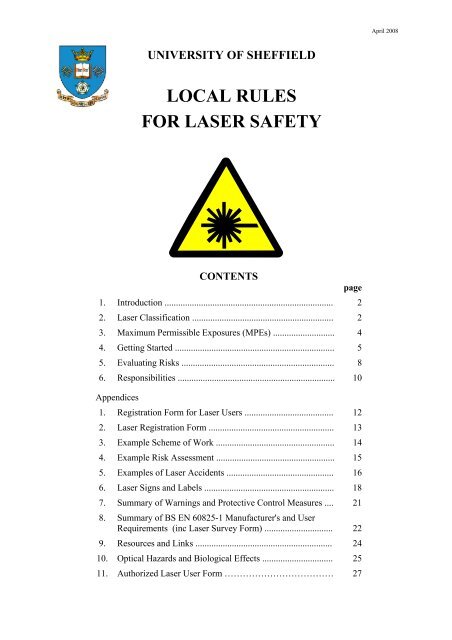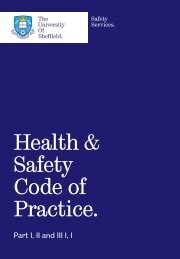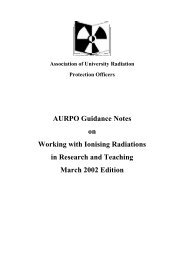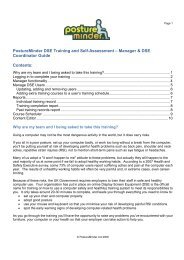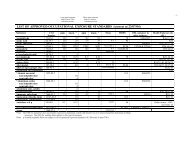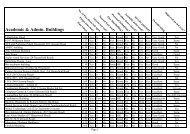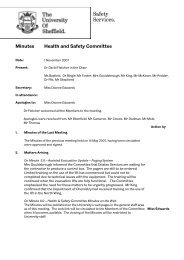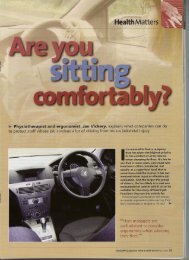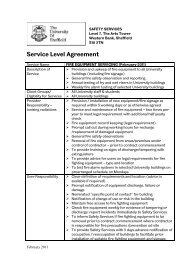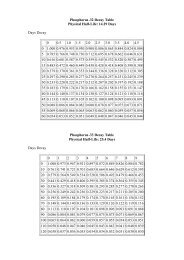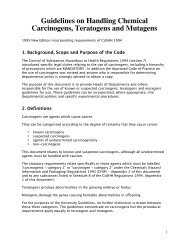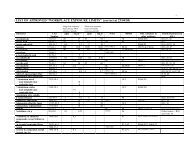local rules for laser safety - Safety.dept.shef.ac.uk - University of ...
local rules for laser safety - Safety.dept.shef.ac.uk - University of ...
local rules for laser safety - Safety.dept.shef.ac.uk - University of ...
Create successful ePaper yourself
Turn your PDF publications into a flip-book with our unique Google optimized e-Paper software.
UNIVERSITY OF SHEFFIELD<br />
LOCAL RULES<br />
FOR LASER SAFETY<br />
CONTENTS<br />
1. Introduction ..........................................................................<br />
page<br />
2<br />
2. Laser Classification .............................................................. 2<br />
3. Maximum Permissible Exposures (MPEs) ........................... 4<br />
4. Getting Started ...................................................................... 5<br />
5. Evaluating Risks ................................................................... 8<br />
6. Responsibilities ..................................................................... 10<br />
Appendices<br />
1. Registration Form <strong>for</strong> Laser Users ....................................... 12<br />
2. Laser Registration Form ....................................................... 13<br />
3. Example Scheme <strong>of</strong> Work .................................................... 14<br />
4. Example Risk Assessment .................................................... 15<br />
5. Examples <strong>of</strong> Laser Accidents ............................................... 16<br />
6. Laser Signs and Labels ......................................................... 18<br />
7. Summary <strong>of</strong> Warnings and Protective Control Measures .... 21<br />
8. Summary <strong>of</strong> BS EN 60825-1 Manuf<strong>ac</strong>turer's and User<br />
Requirements (inc Laser Survey Form) .............................. 22<br />
9. Resources and Links ............................................................ 24<br />
10. Optical Hazards and Biological Effects ............................... 25<br />
11. Authorized Laser User Form ……………………………… 27<br />
April 2008
1. INTRODUCTION<br />
2<br />
April 2008<br />
We all have a responsibility under the Health & <strong>Safety</strong> at Work Act 1974 to ensure that work<br />
with <strong>laser</strong>s is carried out safely. Users have a duty to protect both themselves and others from<br />
the potential hazards involved, particularly when working with the more powerful <strong>laser</strong>s.<br />
Quite <strong>of</strong>ten it is not the <strong>laser</strong> itself that presents the greatest potential hazards but the<br />
associated risks from electrical supplies, cryogenic liquids or chemical dyes.<br />
In this document you will find <strong>for</strong>ms <strong>for</strong> registering users (Appendix 1) and equipment<br />
(Appendix 2). Section 3 (Getting Started) will tell you what and who needs to be registered.<br />
The <strong>safety</strong> <strong>of</strong> <strong>laser</strong> products is covered by BS EN 60825. This BS is a `euronorm' based upon<br />
the International Electrotechnical Commission's IEC 60825. Under the 60825 umbrella are a<br />
range <strong>of</strong> standards <strong>for</strong> manuf<strong>ac</strong>turer's and users on <strong>laser</strong>s, fibre optic systems, <strong>laser</strong> guards,<br />
components etc. Of particular importance <strong>for</strong> user's are: BS EN 60825-1:2007 ‘Equipment<br />
Classification and Requirements’ and, the Technical Report PD IEC TR 60825-14:2004<br />
which is a detailed user's guide that incorporates a risk assessment appro<strong>ac</strong>h to <strong>laser</strong> <strong>safety</strong>.<br />
You are advised to refer to these documents <strong>for</strong> further guidance on classification,<br />
determining MPEs (maximum permissible exposure levels), evaluating risk, control measures,<br />
interlock systems, calculations and biophysical considerations. Also <strong>of</strong> importance are the<br />
standards relating to <strong>laser</strong> <strong>safety</strong> eyewear, namely BS EN 207 and BS EN 208.<br />
The <strong>University</strong> is licensed to <strong>ac</strong>cess and download full text British Standards online. To gain<br />
<strong>ac</strong>cess to this f<strong>ac</strong>ility you need to be set-up to use the <strong>University</strong>’s ‘MUSE’ portal. Access<br />
instructions are then as follows:-<br />
1. Log into MUSE<br />
2. Select ‘Library’ from top index list<br />
3. Under Library eResources select ‘Databases’<br />
4. Select ‘Alphabetical Table’ then ‘B’ and then ‘British Standards’<br />
5. Click on Bsi Online logo and at BSi Online page look to right-hand side and click on<br />
‘BSOL Subscribers’.<br />
6. You are now on the search page. Select ‘search within my subscription’ and<br />
‘standard number’, then enter 60825 in the search box.<br />
You will currently find details <strong>of</strong> 15 standards the first 8 <strong>of</strong> which are current. For your<br />
convenience the main implications <strong>of</strong> the <strong>laser</strong> standards and details <strong>of</strong> the new <strong>laser</strong> classes<br />
are included in this document. Also included in your Local Rules are details <strong>of</strong> two <strong>laser</strong><br />
<strong>ac</strong>cidents at other universities. These are examples <strong>of</strong> what can go wrong when people do not<br />
follow the correct procedures and are careless. (see Appendix 5). A brief summary <strong>of</strong> the<br />
biological effects <strong>of</strong> <strong>laser</strong> radiation is given in appendix 10.<br />
2. LASER CLASSIFICATION<br />
2.1 Lasers<br />
LASER stands <strong>for</strong> light amplification by the stimulated emission <strong>of</strong> radiation but is defined in<br />
BS EN 60825 as 'any device that can be made to produce or amplify electromagnetic radiation<br />
in the wavelength range from 180nm to 1mm primarily by the process <strong>of</strong> controlled<br />
stimulated emission'.<br />
The higher the class <strong>of</strong> <strong>laser</strong> the greater the optical hazard it presents. The classification is<br />
based upon the measured radiation through a given aperture at a set distance (see section 9 <strong>of</strong><br />
BS EN 60825-1:2007), and AELs (<strong>ac</strong>cessible emission levels) have been set <strong>for</strong> e<strong>ac</strong>h class <strong>of</strong>
<strong>laser</strong> (see Tables 4-9, p43-48 BS EN 60825-1: 2007). In the descriptions below the <strong>laser</strong>s<br />
cover the full wavelength range unless a restriction is stated.<br />
3<br />
April 2008<br />
2.2 Class 1 Lasers<br />
These are normally safe either because <strong>of</strong> their inherently low power or because they are a<br />
totally enclosed system where <strong>ac</strong>cess to higher levels <strong>of</strong> <strong>laser</strong> radiation is not possible during<br />
normal operation. NB If <strong>ac</strong>cess panels <strong>of</strong> a totally enclosed system are removed <strong>for</strong> servicing<br />
etc then the <strong>laser</strong> product is no longer Class 1 and the precautions applicable to the embedded<br />
<strong>laser</strong> must be applied until the panels are repl<strong>ac</strong>ed.<br />
2.3 Class 1M Lasers<br />
These are <strong>laser</strong> products, emitting in the wavelength range 302.5nm to 4000nm, whose total<br />
output is in excess <strong>of</strong> that normally permitted <strong>for</strong> Class 1 <strong>laser</strong> products but because <strong>of</strong> their<br />
diverging beams or very low power density do not pose a hazard in normal use and comply<br />
with the measurement conditions <strong>for</strong> a Class 1M product. However they may be hazardous to<br />
the eyes under certain conditions if gathering optics are used with them:a)<br />
With a diverging beam if optics are pl<strong>ac</strong>ed within 100mm <strong>of</strong> the source to<br />
concentrate/collimate the beam.<br />
b) With a large diameter collimated beam viewed with binoculars or a telescope.<br />
2.4 Class 2 Lasers<br />
These are <strong>laser</strong> products that only emit visible radiation in the wavelength range 400nm to<br />
700nm and whose output is less than the appropriate AEL. They are safe <strong>for</strong> <strong>ac</strong>cidental<br />
viewing as protection is af<strong>for</strong>ded by the aversion and blink responses. There is no hazard to<br />
the skin.<br />
2.5 Class 2M Lasers<br />
These are <strong>laser</strong> products that only emit visible radiation in the wavelength range 400nm to<br />
700nm, whose total output is in excess <strong>of</strong> that normally permitted <strong>for</strong> Class 2 <strong>laser</strong> products<br />
but because <strong>of</strong> their diverging beams or very low power density are safe <strong>for</strong> <strong>ac</strong>cidental<br />
viewing during normal use and comply with the measurement conditions <strong>for</strong> a Class 2M<br />
product. However they may be hazardous to the eyes under certain conditions if gathering<br />
optics are used with them:a)<br />
With a diverging beam if optics are pl<strong>ac</strong>ed within 100mm <strong>of</strong> the source to<br />
concentrate/collimate the beam.<br />
b) With a large diameter collimated beam viewed with binoculars or a telescope.<br />
2.6 Class 3R Lasers<br />
These are <strong>laser</strong> products, emitting in the wavelength range 302.5nm to 1mm, that present a<br />
relatively low risk <strong>of</strong> eye damage as their output is restricted to no more than 5 times the AEL<br />
<strong>for</strong> visible Class 2 <strong>laser</strong>s or no more than 5 times the AEL <strong>for</strong> Class 1 devices at other<br />
wavelengths. Direct eye exposure should be prevented.
4<br />
April 2008<br />
2.7 Class 3B Lasers<br />
These are <strong>laser</strong> products that are hazardous to the eye <strong>for</strong> direct intrabeam viewing and from<br />
specular reflections but diffuse reflections are normally safe. They may be hazardous to the<br />
skin at some wavelengths at the upper limit <strong>of</strong> the class. Output levels must be less than the<br />
appropriate AEL <strong>for</strong> Class 3B devices.<br />
2.8 Class 4 Lasers<br />
These are high power devices that exceed the AELs <strong>for</strong> Class 3B devices and are hazardous to<br />
the eyes and skin from direct viewing and from specular reflections. Diffuse reflections may<br />
also be hazardous. They can also have sufficient energy to ignite materials and produce<br />
hazardous fumes. Their use requires extreme caution.<br />
2.9 Example AELs<br />
The AELs <strong>for</strong> He-Ne <strong>laser</strong>s emitting a narrow beam in CW mode at 633nm are as follows:-<br />
• Class 1 and 1M 0.39 mW<br />
• Class 2 and 2M 1 mW<br />
• Class 3R 5 mW<br />
• Class 3B 500 mW<br />
These limits will also apply to other narrow beam CW <strong>laser</strong>s operating in the wavelength<br />
range 400-700nm except <strong>for</strong> Class 1 and 1M devices where there are further restrictions <strong>for</strong><br />
wavelengths
5<br />
April 2008<br />
4. GETTING STARTED<br />
4.1 Registration <strong>of</strong> Personnel - Use Form RPS/L/1 (Appendix 1)<br />
All people intending to work with any class <strong>of</strong> <strong>laser</strong>, except <strong>for</strong> inherently safe Class 1 or<br />
Class 2 devices or embedded <strong>laser</strong> products such as those in <strong>laser</strong> printers or CD players,<br />
should register with <strong>Safety</strong> Services via their Departmental Laser <strong>Safety</strong> Officer (DLSO). The<br />
DLSO will need to establish if people who are only going to use Class 1M or 2M devices are<br />
going to be modifying them and there<strong>for</strong>e require training and full registration. Registered<br />
users will then be issued with the appropriate <strong>safety</strong> in<strong>for</strong>mation and in<strong>for</strong>med <strong>of</strong> the<br />
arrangements <strong>for</strong> eye examinations if applicable. The DLSO should ensure that they receive<br />
copies <strong>of</strong> any relevant schemes <strong>of</strong> work.<br />
4.2 Registration <strong>of</strong> Lasers - Use <strong>for</strong>m RPS/L/2 (Appendix 2)<br />
The use <strong>of</strong> <strong>laser</strong>s, except <strong>for</strong> low power Class 1 devices and embedded <strong>laser</strong> products such as<br />
those used in <strong>laser</strong> printers or CD players, needs to be registered with <strong>Safety</strong> Services. Class<br />
3R, 3B and 4 devices must all be registered individually whereas just the use <strong>of</strong> other lower<br />
powered devices needs to be registered. <strong>Safety</strong> Services will then check the registered <strong>laser</strong>s<br />
to see that they are labelled in <strong>ac</strong>cordance with the guidance notes, operated in <strong>ac</strong>cordance<br />
with the guidance notes and if necessary they will help with the drawing up <strong>of</strong> schemes <strong>of</strong><br />
work to cover their use.<br />
4.2.1 Schemes <strong>of</strong> work (Appendix 3) are required if you are using Class 3B or Class 4 <strong>laser</strong>s<br />
and the beam paths are not totally enclosed. They need to spell out the precautions that will<br />
be taken to ensure containment <strong>of</strong> the <strong>laser</strong> beam inside the experimental area and protection<br />
<strong>of</strong> the operatives.<br />
4.3 Laser <strong>Safety</strong> Training<br />
All people who will be working with any Class 3 or Class 4 <strong>laser</strong> or people who may be<br />
modifying and working on Class 1M or Class 2M devices need to attend Laser <strong>Safety</strong> training<br />
prior to the commencement <strong>of</strong> such work. This training should be repeated as necessary<br />
particularly <strong>for</strong> employees with responsibility <strong>for</strong> supervising and training others. Records <strong>of</strong><br />
training will be kept by <strong>Safety</strong> Services. It is advised that departments keep their own records<br />
as well.<br />
4.4 Eye Examinations<br />
Initial and routine eye examinations <strong>for</strong> <strong>laser</strong> workers are no longer required although if a new<br />
<strong>laser</strong> worker with concerns about their eyesight requests one, this can be arranged, via <strong>Safety</strong><br />
Services, in the Department <strong>of</strong> Ophthalmology at the Royal Hallamshire Hospital.<br />
If there should ever be a case <strong>of</strong> suspected eye damage from <strong>laser</strong>s then <strong>Safety</strong> Services<br />
should be in<strong>for</strong>med immediately and an eye examination must be carried out within 24 hours<br />
at the Royal Hallamshire Hospital. If there has been serious eye damage then referral will be<br />
made to Moorfields Eye Hospital in London.<br />
4.5 Protective Equipment
6<br />
April 2008<br />
If you are working with Class 3B or Class 4 <strong>laser</strong>s and the <strong>laser</strong> beam is not totally enclosed<br />
then you will probably need to wear <strong>laser</strong> <strong>safety</strong> goggles. These may also be considered<br />
necessary <strong>for</strong> work with some Class 3R <strong>laser</strong>s (invisible wavelengths). It is important that<br />
ones with the correct optical density <strong>for</strong> the <strong>laser</strong> you are using are worn. However, there is<br />
no need to buy high optical density <strong>laser</strong> goggles <strong>for</strong> use with some low power <strong>laser</strong>s (e.g. 5-<br />
10mW He-Ne). Quite <strong>of</strong>ten <strong>ac</strong>ceptable goggles can be made from coloured perspex, with an<br />
optical density <strong>of</strong> 2-3, <strong>for</strong> very low cost. Remember however that these simple homemade<br />
devices can only be <strong>for</strong> your own use and not <strong>for</strong> selling on, unless they are CE marked and in<br />
compliance with the Personal Protective Equipment Regulations 2002.<br />
As a general rule alignment goggles, that still allow the user to see where the beam is, are<br />
recommended <strong>for</strong> visible <strong>laser</strong>s whereas high optical density goggles should always be worn<br />
when working with invisible <strong>laser</strong>s. The goggles chosen need to con<strong>for</strong>m with the appropriate<br />
standard: BS EN 207:1999 <strong>for</strong> total eye protection, and BS EN 208:1999 <strong>for</strong> alignment<br />
goggles.<br />
If working with Class 4 <strong>laser</strong>s, and some Class 3B devices operating at UV wavelengths, you<br />
will have to consider the need <strong>for</strong> skin protection. The hands and <strong>for</strong>earms are the areas most<br />
at risk and should there<strong>for</strong>e be covered.<br />
4.6 Undergraduate Work<br />
If reasonably pr<strong>ac</strong>ticable, undergraduate work should be restricted to Class 1/1M, 2/2M or<br />
visible 3R <strong>laser</strong>s, especially <strong>for</strong> class experiments. Sometimes it is possible to downgrade a<br />
higher powered <strong>laser</strong> by the use <strong>of</strong> neutral density filters or beam expanders.<br />
It is important to introduce students to good <strong>safety</strong> pr<strong>ac</strong>tice and a written scheme <strong>of</strong><br />
work/<strong>local</strong> <strong>rules</strong> should be drawn up and posted in the laboratory. In addition, clear written<br />
instructions should be provided <strong>for</strong> e<strong>ac</strong>h student experiment.<br />
Students involved in project work and working with Class 3B or Class 4 <strong>laser</strong>s will be treated<br />
as <strong>laser</strong> workers and should be registered with <strong>Safety</strong> Services. They should also be given<br />
close supervision if working with high-powered <strong>laser</strong>s.<br />
4.7 Labelling <strong>of</strong> Lasers<br />
Inherently safe <strong>laser</strong>s in Class 1 do not need warning labels but <strong>laser</strong>s which are Class 1 by<br />
engineering design and contain an embedded <strong>laser</strong> <strong>of</strong> higher power should be labelled as<br />
'Class 1 - Totally Enclosed System' with details <strong>of</strong> the embedded <strong>laser</strong> clearly displayed (NB<br />
this is not a BS requirement but is thought to be useful additional in<strong>for</strong>mation). All other <strong>laser</strong><br />
products should carry the appropriate warning labels in <strong>ac</strong>cordance with BS EN 60825-1.<br />
Recently manuf<strong>ac</strong>tured <strong>laser</strong>s should all con<strong>for</strong>m to this Standard. For full details <strong>of</strong> labels<br />
required see Appendix 6. Where <strong>laser</strong>s and <strong>laser</strong> systems are not adequately labelled (some<br />
American systems have very small labels that are hard to read and do not comply with our<br />
BS), labels can be supplied by <strong>Safety</strong> Services.<br />
4.8 Laboratory Design<br />
The following considerations relate mainly to the use <strong>of</strong> Class 4 <strong>laser</strong>s but some may be<br />
appropriate <strong>for</strong> Class 3B devices as well.<br />
If pr<strong>ac</strong>ticable the <strong>laser</strong> laboratory should have a high level <strong>of</strong> illumination that will minimise<br />
pupil size and reduce the risk <strong>of</strong> stray <strong>laser</strong> light re<strong>ac</strong>hing the retina. Windows should be kept
7<br />
April 2008<br />
to a minimum or protected by blinds. These should be non-reflective and may need to be<br />
firepro<strong>of</strong> where higher-powered <strong>laser</strong>s are used.<br />
Walls, ceilings and fittings should be painted with a light coloured matt paint to enhance<br />
illumination and minimise specular reflections. Reflecting surf<strong>ac</strong>es such as the use <strong>of</strong> glassfronted<br />
cupboards should be avoided.<br />
Ventilation is important especially with higher-powered <strong>laser</strong>s if cryogens are used, or if toxic<br />
fumes are produced that need to be extr<strong>ac</strong>ted and in this case it is important that the extr<strong>ac</strong>tion<br />
is very close to the source. F<strong>ac</strong>ilities may also be needed <strong>for</strong> the handling <strong>of</strong> toxic chemicals<br />
that are associated with some dye <strong>laser</strong>s.<br />
The laboratory should be equipped with appropriate fire fighting equipment.<br />
Electrical supplies, switch and control gear should be sited in order to:-<br />
• enable the <strong>laser</strong> to be shut down by a person standing next to the <strong>laser</strong>;<br />
• enable the <strong>laser</strong> to be made safe in an emergency from outside the <strong>laser</strong> area;<br />
• prevent <strong>ac</strong>cidental firing <strong>of</strong> a <strong>laser</strong>;<br />
• provide an indication <strong>of</strong> the state <strong>of</strong> readiness <strong>of</strong> the <strong>laser</strong>;<br />
• enable personnel to stand in a safe pl<strong>ac</strong>e;<br />
• provide sufficient and adequate power supplies <strong>for</strong> all ancillary equipment and<br />
apparatus so that the use <strong>of</strong> trailing leads is minimised.<br />
4.9 Experimental set-up<br />
Be<strong>for</strong>e starting to use your <strong>laser</strong> there are a number <strong>of</strong> basic risk reduction measures that<br />
should be considered.<br />
• Can a lower powered <strong>laser</strong> be used?<br />
• Can output power <strong>of</strong> <strong>laser</strong> be restricted if full power is not needed?<br />
• Can intra-beam viewing be prevented by engineering design?<br />
• Can <strong>laser</strong> be used in a screened <strong>of</strong>f area - limiting potential <strong>for</strong> others to be affected?<br />
• Can work be carried out in a total enclosure?<br />
• Beam paths should be as short as possible, optical reflections should be minimised and<br />
the beam terminated with an energy absorbing non-reflective beam stop.<br />
• Laser should be securely fixed to avoid displ<strong>ac</strong>ement and unintended beam paths.<br />
• If pr<strong>ac</strong>ticable align powerful <strong>laser</strong>s with low-power devices that are safe <strong>for</strong> <strong>ac</strong>cidental<br />
viewing, or reduce the power <strong>of</strong> the <strong>laser</strong> by turning it down or introducing neutral<br />
density filters. The aim should be to get the output power
8<br />
April 2008<br />
5. EVALUATING RISKS<br />
It is important that an adequate risk assessment is carried out <strong>of</strong> every <strong>laser</strong> installation and<br />
associated equipment. The classification <strong>of</strong> the <strong>laser</strong> identifies the optical hazard and it is<br />
important that all other associated hazards are identified and dealt with. Written evidence <strong>of</strong> a<br />
risk assessment will be expected by the HSE when they carry out an inspection. Examples <strong>of</strong><br />
risk assessments can be found at - http://www.<strong>shef</strong>.<strong>ac</strong>.<strong>uk</strong>/<strong>safety</strong>/riskass/index.html and in<br />
Appendix 4.<br />
5.1 Stages in a Risk Assessment<br />
There are basically 5 stages to a risk assessment:<br />
Stage 1: identify potentially dangerous situations<br />
Stage 2: assess risk from these hazards and who is at risk<br />
Stage 3: determine and implement the necessary protective measures<br />
Stage 4: assess residual risk - repeating stage 3 if necessary<br />
Stage 5: record your findings<br />
5.2 Identifying non-optical hazards<br />
The manuf<strong>ac</strong>turer's <strong>safety</strong> guidance material should help in identifying most <strong>of</strong> the associated<br />
hazards. The main non-optical hazards to look out <strong>for</strong> are as follows:electrical<br />
- high voltages and cap<strong>ac</strong>itors used with pulsed <strong>laser</strong>s can present a serious<br />
hazard particularly during servicing<br />
collateral radiation - this could include x-rays, UV, RF visible and IR radiation<br />
noxious fumes - can be released from the <strong>ac</strong>tion <strong>of</strong> high power <strong>laser</strong>s used in<br />
materials processing and surgery<br />
hazardous substances - substances used in dye and excimer <strong>laser</strong>s can be toxic and<br />
carcinogenic, cleaning solutions may also be hazardous<br />
cryogenic liquids - used with high-powered <strong>laser</strong>s can present a burning hazard,<br />
possible oxygen depletion hazard and possibly an explosion hazard from over-pressure<br />
<strong>of</strong> gases in a closed system.<br />
fire and explosion - high-powered (class 4) <strong>laser</strong>s can ignite materials and even<br />
relatively low-powered <strong>laser</strong>s (>35mW) can cause explosions in combustible gases<br />
and dusts<br />
mechanical hazards - from gas cylinders, trailing cables and water hoses, cuts from<br />
sharp objects, handling difficulties with large work pieces.<br />
noise - from discharging cap<strong>ac</strong>itor banks, from some pulsed <strong>laser</strong>s and from some aircooled<br />
<strong>laser</strong>s<br />
Other hazards may also arise from the environment in which the <strong>laser</strong> is used - adverse<br />
temperature and humidity, low light-level conditions, mechanical shock and vibration,<br />
interruptions to the power supply, computer s<strong>of</strong>tware problems and ergonomic problems<br />
caused by poor design <strong>of</strong> the layout <strong>of</strong> equipment. Could cleaners inadvertently disturb<br />
equipment? Is unsupervised <strong>ac</strong>cess allowed to the laboratory?
9<br />
April 2008<br />
5.3 Assessing risk<br />
The people who may be at risk need to be identified. These may include cleaning, service<br />
personnel, other contr<strong>ac</strong>tors, visitors and the public as well as trained operatives.<br />
Risk can be assessed by using quantitative measures that combine the likelihood <strong>of</strong><br />
occurrence with the severity <strong>of</strong> injury; however, in <strong>laser</strong> <strong>safety</strong> it is usually more important to<br />
eliminate the risk <strong>of</strong> injury by adopting appropriate control measures in all situations where<br />
there is the possibility <strong>of</strong> MPEs being exceeded.<br />
5.4 Protective Control Measures<br />
In dealing with any hazard one should look first to containing the hazard if reasonably<br />
pr<strong>ac</strong>ticable by: engineering controls; then by the application <strong>of</strong> administrative controls and<br />
then finally by the use <strong>of</strong> personal protective equipment.<br />
• engineering controls - features incorporated by the manuf<strong>ac</strong>turer or added by the user<br />
to prevent or minimise human <strong>ac</strong>cess 1 to hazardous levels <strong>of</strong> <strong>laser</strong> radiation. They<br />
include: beam enclosures, beam tubes, protective barriers and guards, interlocked<br />
<strong>ac</strong>cess panels etc.<br />
• administrative controls - include display <strong>of</strong> warning signs, <strong>local</strong> <strong>rules</strong>, schemes <strong>of</strong><br />
work and written procedures.<br />
• personal protective equipment - protective eyewear should be appropriate <strong>for</strong> the<br />
power and wavelength <strong>of</strong> the <strong>laser</strong> used and the wavelength and optical density (or<br />
scale number <strong>for</strong> CE marked eyewear) should be clearly marked. For work with<br />
visible <strong>laser</strong>s, alignment goggles are recommended that permit the safe <strong>ac</strong>cidental<br />
viewing <strong>of</strong> the <strong>laser</strong> light. High OD goggles should always be used when working<br />
with invisible <strong>laser</strong> beams. Visible light transmission and the ability to see warning<br />
lights are important considerations when choosing <strong>safety</strong> eyewear. If protective<br />
clothing is needed it may need to be firepro<strong>of</strong>.<br />
The <strong>laser</strong> beam controls normally required are indicated by the <strong>laser</strong> classification. They<br />
should be implemented unless a risk assessment justifying the adoption <strong>of</strong> alternative<br />
protective control measures indicates otherwise. A summary <strong>of</strong> protective control measures is<br />
given in Appendix 7. Whenever deviating from the norm it is important to record your<br />
justification <strong>of</strong> the control measures adopted.<br />
5.5 Assessing residual risk and recording the results<br />
In most circumstances after introducing control measures one should be able to assess the<br />
residual risk as being low. One then needs to produce a report and make it available to all<br />
users so that they are aware <strong>of</strong> all protective measures they should be taking and the<br />
procedures they should be following. (See example risk assessment in Appendix 4)<br />
It should be noted that with the changing nature <strong>of</strong> experimental work it is important that the<br />
risk assessment is routinely reviewed.<br />
1 human <strong>ac</strong>cess – see definition 3.37, p13 in BS EN 60825-1:2007 - any reasonable <strong>ac</strong>cess by part <strong>of</strong> the body<br />
either inside or outside <strong>of</strong> a protective housing with or without the use <strong>of</strong> a tool.
10<br />
April 2008<br />
6. RESPONSIBILITIES<br />
The Vice-Chancellor has overall responsibility <strong>for</strong> ensuring the effective management <strong>of</strong> all<br />
health and <strong>safety</strong> matters including <strong>laser</strong> <strong>safety</strong> in the <strong>University</strong>. A detailed breakdown <strong>of</strong> the<br />
organisation and arrangements <strong>for</strong> health and <strong>safety</strong> management can be found in the<br />
<strong>University</strong>'s Health and <strong>Safety</strong> Code <strong>of</strong> Pr<strong>ac</strong>tice.<br />
All personnel involved in <strong>laser</strong> work have a role to play in ensuring the health and <strong>safety</strong> <strong>of</strong><br />
themselves and others who may be affected by their work. Some key personnel have special<br />
responsibilities related to <strong>laser</strong> <strong>safety</strong> and these are described below.<br />
6.1 Radiation Protection Adviser/Laser <strong>Safety</strong> Officer (LSO)<br />
The <strong>University</strong>'s Radiation Protection Adviser also advises on the use <strong>of</strong> <strong>laser</strong>s in the<br />
<strong>University</strong> and per<strong>for</strong>ms executive duties to ensure that the <strong>University</strong> procedures relating to<br />
<strong>laser</strong> <strong>safety</strong> are followed. The RPA/LSO is responsible <strong>for</strong> training <strong>of</strong> new staff/students,<br />
registration <strong>of</strong> <strong>laser</strong>s and users <strong>of</strong> equipment, provision <strong>of</strong> a measuring service (where<br />
appropriate), inspection <strong>of</strong> all new <strong>laser</strong> f<strong>ac</strong>ilities and routine auditing <strong>of</strong> <strong>laser</strong> f<strong>ac</strong>ilities.<br />
6.2 Departmental Laser <strong>Safety</strong> Officers<br />
In departments where Class 3B and Class 4 <strong>laser</strong>s are used the Head <strong>of</strong> Department in<br />
consultation with the Radiation Protection Adviser should appoint a suitably qualified<br />
member <strong>of</strong> staff as Departmental Laser <strong>Safety</strong> Officer who will be responsible <strong>for</strong> ensuring<br />
that all <strong>laser</strong>s used in the department are registered and used in compliance with these <strong>local</strong><br />
<strong>rules</strong>.<br />
6.2.1 Duties <strong>of</strong> the Departmental Laser <strong>Safety</strong> Officer<br />
The DLSO is responsible <strong>for</strong> the day-to-day safe operation <strong>of</strong> <strong>laser</strong>s in the department in<br />
<strong>ac</strong>cordance with the <strong>University</strong>'s Health & <strong>Safety</strong> Code <strong>of</strong> Pr<strong>ac</strong>tice and Local Rules on the<br />
Safe Use <strong>of</strong> Lasers at the <strong>University</strong> <strong>of</strong> Sheffield. The DLSO should ensure that:-<br />
1. all <strong>laser</strong>s except <strong>for</strong> low power Class 1 devices (and excluding <strong>laser</strong> printers, DVDs<br />
etc) are registered with <strong>Safety</strong> Services. (NB Full registration details only required <strong>for</strong><br />
Class 3 and Class 4 devices see Section 3.1 <strong>of</strong> Local Rules.)<br />
2. all <strong>laser</strong>s are labelled in <strong>ac</strong>cordance with Appendix 6.<br />
3. schemes <strong>of</strong> work are drawn up, where necessary, <strong>for</strong> the safe operation <strong>of</strong> <strong>laser</strong>s (see<br />
example in Appendix 3). These will normally be required <strong>for</strong> all Class 3B and Class 4<br />
when not totally enclosed.<br />
4. personnel intending to work with Class 3R <strong>laser</strong>s and above or who may be working<br />
with modified Class 1M or Class 2M devices are registered with <strong>Safety</strong> Services.<br />
5. all registered <strong>laser</strong> workers receive training in the safe use <strong>of</strong> <strong>laser</strong>s.<br />
6. <strong>laser</strong> <strong>safety</strong> goggles are provided and worn (when appropriate) by all people working<br />
with Class 3B and Class 4 <strong>laser</strong>s when the beam is not totally enclosed.
11<br />
April 2008<br />
7. undergraduates working with <strong>laser</strong>s should use the minimum power <strong>laser</strong> pr<strong>ac</strong>ticable<br />
and follow a written scheme <strong>of</strong> work (see Section 4.6 <strong>of</strong> Local Rules).<br />
8. all <strong>laser</strong>s in the department are used in <strong>ac</strong>cordance with the <strong>University</strong>'s Local Rules.<br />
A summary <strong>of</strong> the requirements pl<strong>ac</strong>ed on manuf<strong>ac</strong>turers and users by BS EN 60825 is given<br />
in Appendix 8 together with a survey <strong>for</strong>m/checklist <strong>for</strong> new <strong>laser</strong> installations. Further, more<br />
detailed in<strong>for</strong>mation, can be obtained by referring to the standards directly.<br />
If a survey reveals non-compliance with BS EN 60825 and a potentially dangerous situation,<br />
the <strong>laser</strong> should not be used until the situation has been remedied by the adoption <strong>of</strong><br />
additional control measures.<br />
6.3 Responsibilities <strong>of</strong> Research Supervisor/Principal Investigator<br />
The health and <strong>safety</strong> management <strong>of</strong> individual research projects is normally delegated to the<br />
research supervisor who has a responsibility to ensure that all work is covered by risk<br />
assessments and where appropriate by written schemes <strong>of</strong> work and protocols. They should<br />
also ensure that their <strong>laser</strong> workers are effectively trained in the operating techniques required<br />
and that inexperienced staff are adequately supervised.<br />
6.4 Responsibilities <strong>of</strong> Laser Users<br />
To observe these Local Rules and Schemes <strong>of</strong> Work applicable to the <strong>laser</strong>s that will be used<br />
and to follow the guidance <strong>of</strong> supervisors and the Departmental Laser <strong>Safety</strong> Officer.<br />
Users should not leave a <strong>laser</strong> experiment running unattended unless a risk assessment has<br />
established that it is safe to do so.<br />
Users have responsibilities <strong>for</strong> their own <strong>safety</strong> and that <strong>of</strong> others who may be affected by<br />
their <strong>ac</strong>ts or omissions.<br />
When working with Class 3B or Class 4 <strong>laser</strong>s and there is the possibility <strong>of</strong> stray <strong>laser</strong> beams<br />
that could damage the eyesight, the appropriate <strong>laser</strong> goggles MUST BE WORN.
Appendix 1<br />
<strong>University</strong> <strong>of</strong> Sheffield<br />
REGISTRATION FORM FOR LASER USERS<br />
Surname: Prename(s):<br />
Email: Date <strong>of</strong> Birth:<br />
Title (Mr,<br />
Ms, Dr etc)<br />
Status (Lecturer,<br />
RA, Technician, etc)<br />
Department: Supervisor:<br />
Lasers to be used:<br />
(indicate power or<br />
class <strong>of</strong> <strong>laser</strong>)<br />
Experiments to be<br />
per<strong>for</strong>med:<br />
Labs to be used:<br />
Date <strong>for</strong>m Submitted<br />
Please give a copy <strong>of</strong> this registration <strong>for</strong>m to :-<br />
12<br />
April 2008<br />
(RPS/L1/2008)<br />
Your Departmental Laser <strong>Safety</strong> Officer, and,<br />
then send the <strong>for</strong>m to: Trevor Moseley, <strong>Safety</strong> Services, 40 Victoria St.
Department:<br />
Labs used:<br />
Responsible Person:<br />
Make, Model &s/n<br />
Lasing medium: (e.g. He-Ne)<br />
Mode <strong>of</strong> operation: …..<br />
(e.g. CW or pulsed)<br />
Appendix 2<br />
<strong>University</strong> <strong>of</strong> Sheffield<br />
LASER REGISTRATION FORM<br />
Pulse Duration: Pulse Rep Frequency:<br />
Wavelengths Used:<br />
Max Output Power/ or<br />
Pulse energy<br />
Beam Diameter (mm):<br />
Beam Divergence:<br />
(specify mR or deg, full or half angle)<br />
Brief description <strong>of</strong> use:<br />
Identified Hazards<br />
(see section 5.2 <strong>of</strong> Local Rules)<br />
Risk Assessment Per<strong>for</strong>med ?<br />
What goggles are available ?<br />
Signature:<br />
Date:<br />
CLASS OF<br />
LASER<br />
SCHEME<br />
OF WORK<br />
FOR OFFICE USE<br />
RISK<br />
ASSESSMENT<br />
13<br />
DATE<br />
INSPECTED<br />
April 2008<br />
(RPS/L2/2005)
Appendix 3 - EXAMPLE SCHEME OF WORK<br />
Laser Scheme <strong>of</strong> Work Class 4 3W 635nm Diode Laser (CW)<br />
in K117 Dept <strong>of</strong> Surgery, RHH<br />
14<br />
April 2008<br />
Experiments: Photodynamic therapy in vitro and using mice.<br />
Person responsible: Pr<strong>of</strong> N Brown<br />
Authorised operatives: Pr<strong>of</strong> N Brown<br />
Dr SL Hankin<br />
General Precautions<br />
1. Only the above named personnel are permitted to use this <strong>laser</strong>. They must be familiar<br />
with the manuf<strong>ac</strong>turer's and the <strong>University</strong>'s <strong>safety</strong> in<strong>for</strong>mation (includes these Local<br />
Rules).<br />
2. When not in use the key to the <strong>laser</strong> (or other means <strong>of</strong> controlling <strong>ac</strong>cess) should be<br />
kept separately from the <strong>laser</strong>, to prevent unauthorised use.<br />
3. All beam paths shall be kept as short as possible and enclosed whenever reasonably<br />
pr<strong>ac</strong>ticable.<br />
4. The area in which this <strong>laser</strong> is used should be a designated <strong>laser</strong> area, and have the<br />
appropriate warning notice on the door.<br />
Specific considerations relating to this experiment<br />
The <strong>laser</strong> should be sited at least 1.1m away from the window, (NOHD is 1.09m) and the<br />
blinds should be closed.<br />
Be<strong>for</strong>e switching the <strong>laser</strong> on:<br />
1) The fibre optic head must be securely mounted and pointing vertically down on to a<br />
non-reflective surf<strong>ac</strong>e.<br />
2) The appropriate <strong>safety</strong> eyewear should be worn that gives at least OD 2.3 ( L3 ) at<br />
635nm. Only those wearing <strong>safety</strong> eyewear are permitted in the operating area.<br />
3) The 'Laser in Use - Do not Enter' sign should be posted on the entrance door.<br />
The <strong>laser</strong> must be aligned using the lowest pr<strong>ac</strong>ticable power setting.<br />
The <strong>laser</strong> should not be left unattended unless a remote interlock connector linked to the door<br />
prevents unauthorised <strong>ac</strong>cess. (Expected experimental times are 5 min in vitro and 20min<br />
irradiation <strong>of</strong> mice.)<br />
Because <strong>of</strong> the diverging nature <strong>of</strong> the beam the eye and skin hazard from these <strong>laser</strong><br />
experiments is low. The only other hazard identified with this work is from the cabling. All<br />
cabling should be tied/taped b<strong>ac</strong>k away from the operating area to prevent any tripping hazard<br />
and damage to the alignment <strong>of</strong> the fibre optic.<br />
Copies <strong>of</strong> this scheme <strong>of</strong> work should be issued to all personnel using the <strong>laser</strong>, and should<br />
also be posted in the laboratory.<br />
Laser <strong>Safety</strong> Officer .................................................................................. Date ...................
Appendix 4: EXAMPLE RISK ASSESSMENT<br />
General Risk Assessment: Polariser Laboratory (MRI)<br />
• Laboratory <strong>ac</strong>cess restricted to authorized operators only when <strong>laser</strong> is in use<br />
• Maintenance and cleaning staff admitted only under supervision when all <strong>laser</strong>s and HV supplies are turned <strong>of</strong>f.<br />
Hazard Potential Risk Precautions Residual<br />
Risk<br />
Optical hazard from<br />
<strong>laser</strong>.<br />
(Totally enclosed<br />
CLASS 4 - 100W IR)<br />
Serious damage to eyes and skin<br />
when <strong>ac</strong>cess panels removed<br />
High Voltage supplies Danger <strong>of</strong> death from<br />
electrocution. Damage to<br />
Asphyxiation from<br />
Nitrogen<br />
Trip hazard from<br />
trailing cables and air<br />
pipes<br />
equipment<br />
Suffocation if large amounts <strong>of</strong><br />
air become displ<strong>ac</strong>ed from the<br />
room<br />
Damage to individuals through<br />
falling, and striking head/limbs<br />
on steel benches or frame<br />
Laser and optics contained in an interlocked system. However, <strong>ac</strong>cess can<br />
be gained to the assembly <strong>for</strong> changing optical cell and when changing<br />
He-3 cylinder. Used by trained operatives only. Laser goggles provided<br />
must be worn until a satisf<strong>ac</strong>tory light tightness test has been per<strong>for</strong>med.<br />
14<br />
HV supplies turned <strong>of</strong>f when not in use.<br />
Never leave unconnected.<br />
Air extr<strong>ac</strong>tion system is continually in use giving 5 changes/hour. Subject<br />
to annual inspection. Volume <strong>of</strong> liquid nitrogen in room kept to a<br />
minimum and oxygen deficiency sensor fitted.<br />
All cables to run under walkway ramps.<br />
All walkways to be kept clear<br />
Heater Fire-risk, burns to personnel. The heater is protected by an air-flow interlock device. If the air flow is<br />
cut <strong>of</strong>f then the heater (and <strong>laser</strong> are cut <strong>of</strong>f).<br />
Hazard warning notice displayed<br />
Project Supervisor : EJR van Beek<br />
April 2008<br />
Low<br />
Low<br />
Low<br />
Low<br />
Low
Appendix 5<br />
EXAMPLES OF LASER ACCIDENTS<br />
16<br />
April 2008<br />
1. At a Midlands <strong>University</strong> in the UK in 1999<br />
Late one afternoon a postgraduate student was aligning two <strong>laser</strong>s at different wavelengths<br />
that had been set up in a relatively new configuration. The beam from a dye <strong>laser</strong> (720nm, 10<br />
mJ, 10 ns pulse at 10 Hz) was passed through a dichroic mirror coated <strong>for</strong> high reflection at<br />
266 nm in order to combine it with the beam from a fourth harmonic Nd:YAG <strong>laser</strong> (266 nm,<br />
50 mJ, 10 ns pulse at 10 Hz). This configuration resulted in a partial reflection from the rear<br />
<strong>of</strong> this mirror (approximately 5% <strong>of</strong> the dye <strong>laser</strong>) in an upward direction. Temporarily<br />
<strong>for</strong>getting the presence <strong>of</strong> the stray beam, the person on leaning over the top <strong>of</strong> the apparatus<br />
received a single pulse <strong>of</strong> light from the dye <strong>laser</strong> reflection. This immediately left a large<br />
blind spot in the person’s central vision in one eye. The person was not wearing protective<br />
eyewear as it was claimed they could not see that the beams they were aligning were<br />
coincident (but both were at invisible wavelengths so they could only see the fluorescence).<br />
The experiment was shut down and the person was <strong>ac</strong>companied to the <strong>local</strong> hospital Eye<br />
Unit. On examination the person was in<strong>for</strong>med that there was a small burn on the fovea and<br />
that he would be referred to a consultant as a matter <strong>of</strong> urgency. As to the absence <strong>of</strong> beam<br />
enclosures (drainpipes had been used previously), because <strong>of</strong> the orientation <strong>of</strong> the<br />
experiment being changed these had not been re-incorporated at this stage. The source <strong>of</strong> the<br />
reflection had allegedly been identified prior to the injury and this had been listed as an <strong>ac</strong>tion<br />
to do by the injured person. There was some concern with regard to the examination and<br />
advice received from the <strong>local</strong> hospital Eye Unit. It was concluded that the most appropriate<br />
<strong>ac</strong>tion was to get the injured person to the Moorfields Eye Hospital, Accident and Emergency<br />
Unit (London) as soon as possible (the afternoon after the incident) to obtain a second<br />
examination. It was confirmed that the fovea had been damaged leading to a blind spot and<br />
peripheral blurring in the left eye. As a consequence the following may be <strong>of</strong> use to others:<br />
a). Risk assessments need to be scrutinised, monitored and audited so that it can be<br />
shown that they are suitable and sufficient. Essentially three elements related to the<br />
optical hazard need to be covered (i.e. initial set up/alignment, normal<br />
operation/tweaking and the introduction <strong>of</strong> new components) and protocols detailing<br />
precautions need to be in pl<strong>ac</strong>e. Appropriate justification <strong>of</strong> procedures outside <strong>of</strong><br />
conventional guidance need to be documented. Associated hazards need to be dealt<br />
with also.<br />
b). The importance <strong>of</strong> following procedures, such as eliminating stray<br />
beams/reflections and enclosing exposed beams as far as reasonably pr<strong>ac</strong>ticable needs<br />
to be strongly re-emphasised. Human f<strong>ac</strong>tors need to be taken into <strong>ac</strong>count especially<br />
where there may be hazardous open beam work; in this case an eagerness to get results<br />
may have been a contributory f<strong>ac</strong>tor.<br />
c). Procedures in the event <strong>of</strong> an injury or suspected injury need to be in pl<strong>ac</strong>e and<br />
effective. In most <strong>laser</strong> eye injuries there is not a lot that can be done to rectify<br />
damage; it is essential that competent examinations are carried out as soon as possible<br />
and within 24 hours <strong>of</strong> the injury. Referral to Moorfields Eye Hospital in London<br />
should be made in the event <strong>of</strong> a serious <strong>laser</strong> eye injury. Thus in light <strong>of</strong> the number<br />
<strong>of</strong> injuries recently in the UK research institutions, emergency procedures in pl<strong>ac</strong>e<br />
need to be checked as to whether they are appropriate (all Class 3B/Class 4 <strong>laser</strong> users<br />
and their supervisors need to be aware <strong>of</strong> what to do). (Arrangements with Dept <strong>of</strong><br />
Ophthalmology, RHH last checked Oct 2004. - see also Para 4.4)
17<br />
April 2008<br />
2. At Los Alamos National Laboratory, Cali<strong>for</strong>nia USA, 2004<br />
On 14 th July 2004 an undergraduate student was injured whilst working with a Nd:YAG <strong>laser</strong><br />
in the Chemistry Division. The work involved the use <strong>of</strong> two <strong>laser</strong>s one to analyse particles<br />
(L1) and one to generate and suspend particles in a target chamber (L2). On the day in<br />
question the Principle Investigator (PI) was using L1 in flash-lamp mode to illuminate the<br />
suspended particles. After firing and shutting down L2 the PI removed the beam stop from<br />
behind the target chamber and looked inside whilst L1's flash lamps continued to operate.<br />
When the student bent down to look too she immediately saw a flash and a reddish-brown<br />
spot in her left eye - a hole had been burnt in her retina.<br />
An investigation followed and PI claimed that he was operating L1 with the Q-switched<br />
trigger cable disconnected from the pulse generator, however the investigating team<br />
confirmed that the <strong>laser</strong> could not lase under those conditions.<br />
The <strong>ac</strong>cident investigation team found the following failures <strong>of</strong> management and procedures:-<br />
• Neither the PI nor the student were wearing <strong>laser</strong> eye protection and there were<br />
no engineered <strong>safety</strong> measures in pl<strong>ac</strong>e.<br />
• The PI did not recheck beam alignment or <strong>laser</strong> condition or check <strong>for</strong> beam<br />
reflections on July 13 or 14.<br />
• The PI prepared an insufficiently detailed risk assessment/scheme <strong>of</strong> work and<br />
had not updated it to reflect experimental changes.<br />
• The student had not received proper pre-job training and had been asked to sign<br />
up to the scheme <strong>of</strong> work after the <strong>ac</strong>cident.<br />
• Line managers responsible <strong>for</strong> the area had not monitored PIs <strong>safety</strong> pr<strong>ac</strong>tices<br />
• The Line Manager and Laser <strong>Safety</strong> Officer had signed <strong>of</strong>f PIs risk<br />
assessment/scheme <strong>of</strong> work without noting the l<strong>ac</strong>k <strong>of</strong> detail.<br />
• Management did not ensure that PI followed the Local Rules<br />
• No PI training in relation to mentoring students<br />
As a result <strong>of</strong> this incident the Los Alamos Lab was required to review its procedures,<br />
improve <strong>safety</strong> management and improve training <strong>of</strong> mentors and students to ensure that this<br />
type <strong>of</strong> incident would hopefully not occur again.<br />
Four top scientists f<strong>ac</strong>ed disciplinary <strong>ac</strong>tion after the <strong>ac</strong>cident, the Principal Investigator was<br />
s<strong>ac</strong>ked and there was considerable disruption to the work <strong>of</strong> the laboratory during the course<br />
<strong>of</strong> the investigation and the procedural review.<br />
Both these <strong>ac</strong>cidents have similarities. In neither case was <strong>safety</strong> eyewear being worn. In both<br />
cases 2 <strong>laser</strong>s were being used and the individual was struck in the eye with a pulse from a<br />
pulsed <strong>laser</strong> that they were not expecting. If you are viewing an experimental set-up either:<br />
• a proper shutdown procedure must be followed be<strong>for</strong>e looking down beam-paths, or<br />
• <strong>safety</strong> eyewear must be worn( but not to deliberately look down beam paths!), or<br />
• viewing should be via a video camera in a safe location.
Appendix 6<br />
LASER SIGNS AND LABELS<br />
18<br />
April 2008<br />
DESIGNATED LASER AREAS<br />
The points <strong>of</strong> <strong>ac</strong>cess to areas in which Class 3B or Class 4 <strong>laser</strong> products are used must be<br />
marked with warning signs complying with BS 5378 and the Health & <strong>Safety</strong> (<strong>Safety</strong> Signs<br />
and Signals) Regulations 1996. The signs shall incorporate the following in<strong>for</strong>mation:<br />
1) hazard warning symbol<br />
2) highest class <strong>of</strong> <strong>laser</strong> in the area<br />
3) responsible person with cont<strong>ac</strong>t details<br />
For the area signs the specifications are quite simple -50%<br />
<strong>of</strong> the area should be yellow and the width <strong>of</strong> the bl<strong>ac</strong>k<br />
border is 0.06 x the length <strong>of</strong> the side.<br />
A more detailed specification is given <strong>for</strong> the symbol used in<br />
labels, see spec on p26 <strong>of</strong> BS EN 60825-1:2007<br />
LASER LABELS<br />
Laser labels are required <strong>for</strong> all <strong>laser</strong> products except <strong>for</strong> low power Class 1 devices. They are<br />
designed to give a warning <strong>of</strong> <strong>laser</strong> radiation, the class <strong>of</strong> <strong>laser</strong>, basic precautions and the<br />
<strong>laser</strong>'s char<strong>ac</strong>teristics.<br />
The <strong>laser</strong> warning uses the same symbol as <strong>for</strong> the door sign in an appropriate size <strong>for</strong> the<br />
<strong>laser</strong> to be labelled and should be clearly visible. Supplementary in<strong>for</strong>mation should be bl<strong>ac</strong>k<br />
text on a yellow b<strong>ac</strong>kground in <strong>ac</strong>cordance with Fig 2 p27 <strong>of</strong> BS EN 60825-1:2007.<br />
Where the size <strong>of</strong> the <strong>laser</strong> product does not permit the affixing <strong>of</strong> a reasonably sized label, a<br />
sign should be displayed in close proximity to the <strong>laser</strong> with all appropriate in<strong>for</strong>mation on.<br />
In<strong>for</strong>mation over and above that specified by BS EN 60825-1 is required <strong>for</strong> Class 1 products<br />
that are Class 1 by engineering design. For these types <strong>of</strong> <strong>laser</strong> product we specify that they<br />
are totally enclosed systems and give details <strong>of</strong> the <strong>laser</strong> enclosed. The BS requirement is just<br />
to describe them on the outside as a Class 1 <strong>laser</strong> product.<br />
Details <strong>of</strong> wording required on explanatory labels is given below.<br />
Class 1 (by engineering design)<br />
No hazard warning label.<br />
Explanatory label bearing the words: CLASS 1 LASER PRODUCT<br />
A TOTALLY ENCLOSED LASER SYSTEM<br />
CONTAINING A CLASS ..... LASER<br />
In addition e<strong>ac</strong>h <strong>ac</strong>cess panel or protective housing shall bear the words:-<br />
CAUTION - CLASS .... LASER RADIATION WHEN OPEN<br />
with the appropriate class inserted and then followed by the hazard warning associated with<br />
that class <strong>of</strong> <strong>laser</strong> (see warning statements in following labels).
Class 1M<br />
No hazard warning label.<br />
Explanatory label bearing the words:<br />
NB-'Optical Instruments' can be supplemented with either 'Binoculars or Telescopes' (<strong>for</strong> a<br />
large diameter collimated beam) or 'Magnifiers' (<strong>for</strong> a highly diverging beam).<br />
Class 2<br />
Label with hazard warning symbol.<br />
Explanatory label bearing the words:-<br />
Class 2M<br />
Label with hazard warning symbol.<br />
Explanatory label bearing the words:-<br />
NB-'Optical Instruments' can be supplemented with either 'Binoculars or Telescopes' (<strong>for</strong> a<br />
large diameter collimated beam) or 'Magnifiers' (<strong>for</strong> a highly diverging beam).<br />
Class 3R<br />
Label with hazard warning symbol.<br />
Explanatory label bearing the words:-<br />
For λ 400nm-1400nm ONLY.<br />
LASER RADIATION<br />
DO NOT VIEW DIRECTLY<br />
WITH OPTICAL INSTRUMENTS<br />
CLASS 1M LASER PRODUCT<br />
LASER RADIATION<br />
DO NOT STARE INTO BEAM<br />
CLASS 2 LASER PRODUCT<br />
NB - For other λ repl<strong>ac</strong>e 'AVOID DIRECT EYE EXPOSURE' with 'AVOID EXPOSURE<br />
TO BEAM'<br />
19<br />
April 2008<br />
LASER RADIATION<br />
DO NOT STARE INTO BEAM OR VIEW<br />
DIRECTLY WITH OPTICAL INSTRUMENTS<br />
CLASS 2M LASER PRODUCT<br />
LASER RADIATION<br />
AVOID DIRECT EYE EXPOSURE<br />
CLASS 3R LASER PRODUCT
Class 3B<br />
Label with hazard warning symbol.<br />
Explanatory label bearing the words:-<br />
Class 4<br />
Label with hazard warning symbol.<br />
Explanatory label bearing the words:-<br />
LASER RADIATION<br />
AVOID EXPOSURE TO BEAM<br />
CLASS 3B LASER PRODUCT<br />
20<br />
April 2008<br />
LASER RADIATION<br />
AVOID EYE OR SKIN EXPOSURE TO<br />
DIRECT OR SCATTERED RADIATION<br />
CLASS 4 LASER PRODUCT<br />
Aperture Labels <strong>for</strong> Class 3R, Class 3B & Class 4 <strong>laser</strong>s<br />
E<strong>ac</strong>h Class 3R, Class 3B and Class 4 <strong>laser</strong> product shall display a label close to where the<br />
beam is emitted bearing the words 'LASER APERTURE' or 'AVOID EXPOSURE - LASER<br />
RADIATION IS EMITTED FROM THIS APERTURE'. This label can take the <strong>for</strong>m <strong>of</strong> an<br />
arrow if this displays more meaning:-<br />
LASER<br />
APERTURE<br />
Radiation Output and Standards In<strong>for</strong>mation<br />
All <strong>laser</strong> products, except <strong>for</strong> low power Class 1 devices, shall be described on an explanatory<br />
label with details <strong>of</strong> :-<br />
• maximum output<br />
• emitted wavelength<br />
• whether <strong>laser</strong> is visible, invisible or both<br />
• pulse duration (if appropriate)<br />
• name and publication date <strong>of</strong> classification standard<br />
We have also put on our labels details <strong>of</strong> the type <strong>of</strong> <strong>laser</strong> and the lasing medium, although<br />
this is not a BS requirement.<br />
In<strong>for</strong>mation to be put on explanatory labels may be combined and LED shall be used to<br />
repl<strong>ac</strong>e the word '<strong>laser</strong>' when appropriate.
Appendix 7<br />
21<br />
April 2008<br />
SUMMARY OF WARNINGS & PROTECTIVE CONTROL MEASURES<br />
CLASS PROTECTIVE CONTROL MEASURES<br />
1 No protective control measures <strong>for</strong> normal use (NB special precautions may be<br />
needed <strong>for</strong> service work on embedded <strong>laser</strong> products.)<br />
1M Prevent direct viewing with magnifying optics. (NB fitting external optics that<br />
decrease beam divergence may affect classification) + see footnote<br />
2 Do not stare into beam.<br />
Do not direct the beam at other people or into public areas.<br />
2M Do not stare into beam<br />
Do not direct the beam at other people or into public areas.<br />
Terminate beam at end <strong>of</strong> useful path with a non-specular beam stop.<br />
Prevent direct viewing with magnifying optics. (NB fitting external optics that<br />
decrease beam divergence may affect classification) + see footnote<br />
3R Prevent direct eye exposure to the beam.<br />
Do not direct the beam at other people or into public areas. + see footnote<br />
3B and 4 Class 3B and Class 4 <strong>laser</strong> products should not be used without first carrying<br />
out a risk assessment to determine the protective control measures necessary to<br />
ensure safe operation. Where reasonably pr<strong>ac</strong>ticable engineering means should<br />
be used reduce the <strong>laser</strong> class to a totally enclosed Class 1 <strong>laser</strong> product.<br />
The use <strong>of</strong> any Class 3B or Class 4 <strong>laser</strong> without an interlocked enclosure will<br />
require a written scheme <strong>of</strong> work. Even with an enclosure written procedures<br />
will be necessary if the user is involved in any alignment procedures that<br />
require over-riding <strong>of</strong> interlocks.<br />
Class 3B and Class 4 <strong>laser</strong> products require the control <strong>of</strong> <strong>ac</strong>cess to the area<br />
where the <strong>laser</strong> is operated by the use <strong>of</strong> a remote interlock, the use <strong>of</strong> key<br />
control, emission indicators, beam shutters, removal <strong>of</strong> reflecting surf<strong>ac</strong>es that<br />
could be struck by an errant beam, beam enclosures wherever pr<strong>ac</strong>tical, the use<br />
<strong>of</strong> eye protection and protective clothing as appropriate, training <strong>of</strong> staff and the<br />
appointment <strong>of</strong> a Laser <strong>Safety</strong> Officer.<br />
+ Classes 1M, 2M and 3R may also require training <strong>of</strong> staff, care with beam paths and<br />
specular reflections - see BS EN 60825 -1:2007 and PD IEC TR 60825-14:2004 <strong>for</strong> more<br />
details.<br />
Special attention should also be given to other non-optical hazards such as risk <strong>of</strong> electric<br />
shock, hazardous chemicals, cryogenic liquids and flying debris from targets to name but a<br />
few. It is <strong>of</strong>ten the non-optical hazards that pose the greatest risk - one could be blinded in<br />
one eye from a powerful <strong>laser</strong> but electrocution could be fatal. Some non-optical hazards may<br />
be present with even Class 1 <strong>laser</strong> products.
Appendix 8<br />
SUMMARY OF BS EN 60825-1:2007<br />
MANUFACTURER'S AND USER REQUIREMENTS<br />
1 Remote interlock - connection provided by the manuf<strong>ac</strong>turer <strong>for</strong> door or enclosure<br />
interlock <strong>for</strong> Class 3B and Class 4 <strong>laser</strong>s<br />
2 <strong>Safety</strong> interlocks - required <strong>for</strong> <strong>ac</strong>cess panels on Class3R, 3B and 4 <strong>laser</strong> systems<br />
3 Key control a key or similar device is required to control unauthorised<br />
operation <strong>of</strong> Class 3B and Class 4 <strong>laser</strong>s<br />
22<br />
April 2008<br />
4 Emission indicator - an audible or visible indicator should be provided by the<br />
manuf<strong>ac</strong>turer <strong>for</strong> e<strong>ac</strong>h Class 3R <strong>laser</strong> ( except wavelengths 400-<br />
700nm) and e<strong>ac</strong>h Class 3B and Class 4 <strong>laser</strong> system<br />
5 Beam stop or<br />
attenuator/shutter -<br />
should be provided by the manuf<strong>ac</strong>turer <strong>for</strong> e<strong>ac</strong>h Class 3B or<br />
Class 4 <strong>laser</strong> system<br />
6 Beam termination - the user should ensure that all beam paths are terminated at the<br />
end <strong>of</strong> their useful path. (Does not apply to Class 1 devices)<br />
7 Beam level - avoid eye level<br />
8 Beam enclosure - to guard against specular reflections from Class 3R, Class 3B and<br />
Class 4 <strong>laser</strong>s - can mean anything from screening the<br />
experimental area or piping the beam up to a total enclosure.<br />
9 Eye protection - required <strong>for</strong> open beam work with invisible beam Class 3R and<br />
all Class 3B and Class 4 devices.<br />
10 Protective clothing mainly required <strong>for</strong> Class 4 <strong>laser</strong>s but be careful with Class 3B<br />
UV <strong>laser</strong>s as well, may need fire resistant material <strong>for</strong> some <strong>laser</strong>s<br />
11 Eye examinations - only required after an <strong>ac</strong>cident but may be important to people<br />
with poor eyesight working with Class 3B or Class 4 <strong>laser</strong>s<br />
12 Training - required <strong>for</strong> people working with any Class 3 or Class 4 <strong>laser</strong> and<br />
any modified Class 1M or Class 2M devices.<br />
13 Laser labels - required <strong>for</strong> all <strong>laser</strong>s except low power Class 1 ( though need not<br />
be directly affixed if the size <strong>of</strong> the <strong>laser</strong> product does not permit<br />
this)<br />
14 Door/Area signs - required <strong>for</strong> Class 3B and Class 4 <strong>laser</strong>s indoors and also <strong>for</strong><br />
Class 1M, 2M and 3R if used outdoors
Laser Survey Form<br />
The following <strong>laser</strong> survey <strong>for</strong>m takes all the manuf<strong>ac</strong>turing and user requirements into<br />
<strong>ac</strong>count and provides a checklist to see if the <strong>laser</strong> installation is observing all the<br />
requirements recommended by BS EN 60825. Where a box cannot be 'ticked <strong>of</strong>f' the user<br />
should be employing some other protective measure justified by a risk assessment.<br />
LASER SURVEY FORM DEPT:<br />
Date: LAB:<br />
Make: Type: Mode:<br />
Model & s/n: λ: Power:<br />
23<br />
April 2008<br />
Precautions 1M 2 2M 3R 3B 4 1(E)<br />
Remote interlock n/a n/a n/a n/a n/a<br />
<strong>Safety</strong> interlocks n/a n/a n/a<br />
Key control n/a n/a n/a n/a<br />
Emission indicator n/a n/a n/a<br />
Beam stop/shutter n/a n/a n/a n/a n/a<br />
Beam terminator n/a n/a<br />
Beam level n/a<br />
Beam enclosure n/a n/a n/a<br />
Eye protection n/a n/a n/a n/a<br />
Protective clothing n/a n/a n/a n/a n/a<br />
Eye examinations n/a n/a n/a n/a n/a<br />
Training n/a<br />
Laser labels<br />
Door/Area signs n/a n/a n/a n/a n/a<br />
Laser installation: satisf<strong>ac</strong>tory/ not satisf<strong>ac</strong>tory<br />
Additional control measures required: .........................................................................................<br />
.......................................................................................................................................................<br />
.......................................................................................................................................................<br />
.......................................................................................................................................................<br />
Survey per<strong>for</strong>med by: ...............................................
Appendix 9<br />
RESOURCES & LINKS<br />
24<br />
April 2008<br />
In<strong>for</strong>mation sources<br />
Further in<strong>for</strong>mation on <strong>laser</strong> <strong>safety</strong> can be found from <strong>ac</strong>cessing the Health Protection Agency<br />
website at:http://www.hpa.org.<strong>uk</strong>/webw/HPAweb&Page&HPAwebAutoListName/Page/115893460770<br />
3?p=1158934607703<br />
HPA/NRPB have published guidance on the purchase and use <strong>of</strong> <strong>laser</strong> pointers:http://www.hpa.org.<strong>uk</strong>/webw/HPAweb&HPAwebStandard/HPAweb_C/1195733794576?p=1<br />
158934607693<br />
The International Commission on Non-Ionising Radiation Protection (ICNRP) has a useful<br />
bibliography <strong>of</strong> recent publications on optical <strong>safety</strong> many <strong>of</strong> which can be freely<br />
downloaded.<br />
http://www.icnirp.org/pubOptical.htm<br />
If it is intended to use <strong>laser</strong>s outdoors one must consult the Civil Aviation Authority (CAA)<br />
guidelines:http://www.caa.co.<strong>uk</strong>/docs/33/CAP736.PDF<br />
Laser <strong>Safety</strong> Equipment and S<strong>of</strong>tware<br />
BFiOptilas market a range <strong>of</strong> <strong>laser</strong>s, power meters, optical components, <strong>laser</strong> <strong>safety</strong> eyewear,<br />
<strong>laser</strong> guards etc and also <strong>of</strong>fer an advice service. In<strong>for</strong>mation on their products can be found<br />
at:http://photonics.bfioptilas.co.<strong>uk</strong>/Laser+<strong>Safety</strong>&Accessories-17.htm<br />
Lasermet sell an extensive range <strong>of</strong> <strong>laser</strong> <strong>safety</strong> products and <strong>laser</strong> <strong>safety</strong> s<strong>of</strong>tware. They also<br />
<strong>of</strong>fer a design and <strong>safety</strong> consultancy service and were founded by one <strong>of</strong> the leading <strong>laser</strong><br />
experts in the UK - Pr<strong>of</strong> Bryan Tozer. A lot <strong>of</strong> useful in<strong>for</strong>mation can be found on their site<br />
at:http://www.<strong>laser</strong><strong>safety</strong>.co.<strong>uk</strong>/<br />
Electro-Optics also market a range <strong>of</strong> <strong>laser</strong>s, power meters, optical components, <strong>laser</strong> <strong>safety</strong><br />
eyewear, <strong>laser</strong> guards etc and also <strong>of</strong>fer an advice service. In<strong>for</strong>mation on their products can<br />
be found at:http://www.electrooptics.com/<br />
Laser Physics UK market a range <strong>of</strong> <strong>laser</strong> <strong>safety</strong> eyewear, power meters, optical components,<br />
<strong>safety</strong> barriers, curtains and blinds and <strong>laser</strong> <strong>safety</strong> s<strong>of</strong>tware. Details can be found at:http://www.<strong>laser</strong>physics<strong>uk</strong>.com
Appendix 10<br />
OPTICAL HAZARDS AND BIOLOGICAL EFFECTS<br />
OF LASER RADIATION<br />
Penetration <strong>of</strong> <strong>laser</strong> radiation into the eye<br />
25<br />
April 2008<br />
NB Short pulsed high peak-power <strong>laser</strong> beams are particularly hazardous to the eye,<br />
especially at wavelengths that re<strong>ac</strong>h the retina, as they deliver a lot <strong>of</strong> energy in a short period<br />
<strong>of</strong> time that can cause irreversible damage. Near infra-red <strong>laser</strong>s are also particularly<br />
hazardous because you can't see the beam but it could be focused on the retina and you would<br />
only be aware <strong>of</strong> it after damage has been caused.<br />
Penetration <strong>of</strong> <strong>laser</strong> radiation into the skin<br />
UV Visible Near IR Far IR<br />
UVC and UVB (180-315nm)<br />
UVA (315-400nm)<br />
Visible and IR-A (400-1400nm)<br />
IR-B (1.4μm - 3.0μm)<br />
IR-C (3.0μm -1 mm
26<br />
April 2008<br />
In general, the skin can tolerate a great deal more exposure than the eye and less research has<br />
been done on damage mechanisms. All wavelengths <strong>of</strong> <strong>laser</strong> output with sufficient power<br />
density can cause surf<strong>ac</strong>e burns <strong>of</strong> the skin and with high-powered Class 4 <strong>laser</strong>s there could<br />
be no warning <strong>of</strong> this occurring. Near infra-red <strong>laser</strong>s are again <strong>of</strong> particular concern because<br />
they are more penetrating and can re<strong>ac</strong>h the subcutaneous layer and UV <strong>laser</strong>s are also <strong>of</strong><br />
concern because <strong>of</strong> the long-term risk <strong>of</strong> developing skin cancer.<br />
Summary <strong>of</strong> biological effects associated with excessive exposure to optical radiation<br />
Spectral Region Eye Skin<br />
UV-C (180-280nm)<br />
erythema (sunburn)<br />
Photokeratitis <strong>ac</strong>celerated skin ageing<br />
UV-B (280-315nm)<br />
increased pigmentation<br />
UV-A (315-400nm) Photochemical catar<strong>ac</strong>t pigment darkening<br />
Visible (400-780nm) Photochemical and<br />
thermal retinal injury<br />
IR-A (780-1400nm) catar<strong>ac</strong>t, retinal burn<br />
IR-B (1.4μm- 3.0μm) aqueous flare, catar<strong>ac</strong>t,<br />
corneal burn<br />
IR-C (3.0μm- 1mm) corneal burn only<br />
photosensitive re<strong>ac</strong>tions<br />
Skin burn<br />
More detailed in<strong>for</strong>mation on biological effects can be found in Annex D to BS-EN 60825-<br />
1:2007. This is also repeated as Annex C to PD IEC TR 60825-14:2004.
Appendix 11<br />
AUTHORIZED LASER USER TRAINING RECORD FORM<br />
Researcher …………………………………………………<br />
Room number …………………………………………………<br />
Lasers used ....………………………………………………<br />
Attended <strong>University</strong> training lecture<br />
Registered as <strong>University</strong> <strong>laser</strong> user<br />
....………………………………………………<br />
....………………………………………………<br />
....………………………………………………<br />
Read <strong>University</strong> <strong>local</strong> <strong>rules</strong> <strong>for</strong> <strong>laser</strong> <strong>safety</strong><br />
Familiar with all hazards within the laboratory and the laboratory's<br />
risk assessment<br />
Trained in use <strong>of</strong> <strong>laser</strong>s named above<br />
Familiar with <strong>laser</strong> schemes <strong>of</strong> work<br />
SIGNED<br />
Researcher ………………………… Date ………………………<br />
Supervisor ………………………… Date ………………………<br />
RETURN THIS FORM TO YOUR DLSO<br />
27<br />
April 2008


